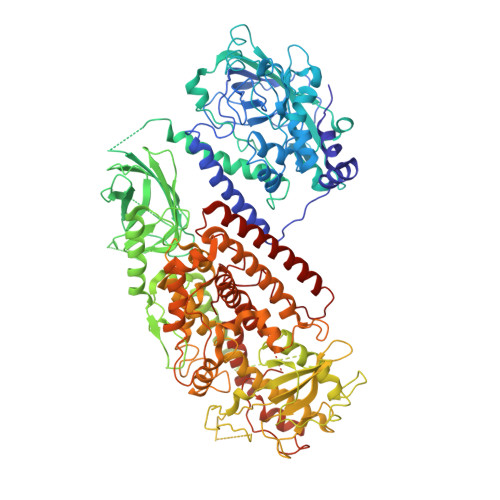A covalent linker allows for membrane targeting of an oxylipin biosynthetic complex.
Gilbert, N.C., Niebuhr, M., Tsuruta, H., Bordelon, T., Ridderbusch, O., Dassey, A., Brash, A.R., Bartlett, S.G., Newcomer, M.E.(2008) Biochemistry 47: 10665-10676
- PubMed: 18785758
- DOI: https://doi.org/10.1021/bi800751p
- Primary Citation of Related Structures:
3DY5 - PubMed Abstract:
A naturally occurring bifunctional protein from Plexaura homomalla links sequential catalytic activities in an oxylipin biosynthetic pathway. The C-terminal lipoxygenase (LOX) portion of the molecule catalyzes the transformation of arachidonic acid (AA) to the corresponding 8 R-hydroperoxide, and the N-terminal allene oxide synthase (AOS) domain promotes the conversion of the hydroperoxide intermediate to the product allene oxide (AO). Small-angle X-ray scattering data indicate that in the absence of a covalent linkage the two catalytic domains that transform AA to AO associate to form a complex that recapitulates the structure of the bifunctional protein. The SAXS data also support a model for LOX and AOS domain orientation in the fusion protein inferred from a low-resolution crystal structure. However, results of membrane binding experiments indicate that covalent linkage of the domains is required for Ca (2+)-dependent membrane targeting of the sequential activities, despite the noncovalent domain association. Furthermore, membrane targeting is accompanied by a conformational change as monitored by specific proteolysis of the linker that joins the AOS and LOX domains. Our data are consistent with a model in which Ca (2+)-dependent membrane binding relieves the noncovalent interactions between the AOS and LOX domains and suggests that the C2-like domain of LOX mediates both protein-protein and protein-membrane interactions.
Organizational Affiliation:
Department of Biological Sciences, Louisiana State University, Baton Rouge, Louisiana 70803, USA.
















